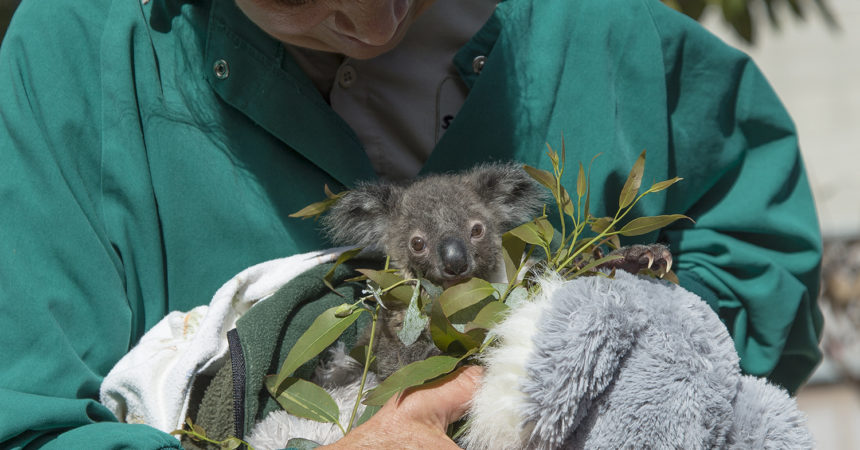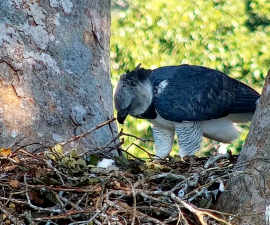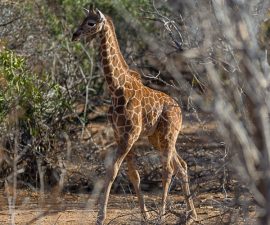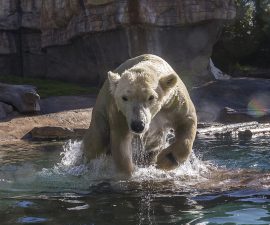An 8-month-old koala joey being cared for round the clock by San Diego Zoo wildlife care specialists is thriving. The male koala joey, named Omeo (pronounced Ooh-me-ooh), lost his mother due to cancer in mid-December, when he was about 5-and-a-half months old and was still in her pouch. To save the joey’s life, Zoo veterinarians and wildlife care specialists intervened, feeding and caring for the little marsupial.
“Omeo has come a long way since we first started taking care of him,” said Kim Weibel,
senior neonatal assisted care specialist, San Diego Zoo. “In the beginning, he was so compromised and so underdeveloped, we wondered if he would make it. However, he has grown stronger, his endurance has increased, and he has nice, thick fur. He is starting to sample eucalyptus, so we hope he will be eating it soon; and the next big step is meeting other koalas, and learning how to socialize and climb—doing all the great things koalas do.”
Omeo requires round-the-clock care, and each day three wildlife care specialists tend to his every need. He is fed a bottle of special milk formula five times a day—at 5:30 a.m., 10 a.m., 2:30 p.m., 7:30 p.m. and 12:30 a.m. Initially, Omeo was living in a faux pouch inside an incubator, with the temperature and humidity set to simulate conditions in his mother’s pouch. As he has grown, he now spends more time in his exercise setting, where he is learning to explore and build muscle tone, by crawling out of the pouch and climbing up onto the back of his plush “stand-in mom.” Wildlife care specialists take him outdoors at least 10 to 20 minutes a day to provide him time in the sun and acclimate him to sights, sounds and smells of the koalas around him.
“It is important we mimic as many natural situations for Omeo as he would receive with his mother,” said Weibel. “We touch him, hold him snug in his faux pouch, we encourage him to grasp onto his plush “stand-in mom” and we provide him eucalyptus, so he can further develop his hand-eye coordination and learn to feed himself.”
When not taking a bottle, exercising or sunning himself, Omeo does what koalas do best—he sleeps most of the day, in his faux pouch or perched in a custom-designed miniature eucalyptus tree. As Omeo continues to grow stronger, his caregivers will encourage him to rely on his own instincts to eat eucalyptus, climb on branches and eventually live in his own habitat at the Zoo’s Australian Outback.
Even though the San Diego Zoo is currently closed to guests due to restrictions related to COVID-19, wildlife care specialists are diligently caring for the animals. “We still have to come in to feed and care for the animals, and it’s our pleasure to do so,” said Weibel. “Working with animals is like seeing your family every day. The Zoo is quiet, and it is different without guests, but we are here to do our jobs and I think the animals appreciate it.”
The San Diego Zoo has housed and cared for koalas since 1925 and has the largest colony of koalas—as well as the most successful breeding program—outside of Australia. Staff at the San Diego Zoo and the San Diego Zoo Institute for Conservation Research are studying koala populations, both at the Zoo and in their Australian habitats, to better understand the species’ complex ecology, mating behaviors and health. The information gleaned from this work will help further develop conservation strategies for koalas.
The San Diego Zoo is globally recognized and a San Diego icon, hosting close to four million guests each year. At the San Diego Zoo, visitors can watch penguins swim with sharks, observe the behavior of century-old Galápagos tortoises, enjoy the beauty of exotic orchids, marvel at the koalas, explore walkthrough aviaries filled with the songs and colors of rare birds, and appreciate the remarkable power of leopards and jaguars. The San Diego Zoo is accredited by the Association of Zoos and Aquariums and the American Association of Museums as a Botanical Garden. When visitors discover the rare and endangered species at the San Diego Zoo, they are directly contributing, through admissions and on-grounds sales, to the efforts of San Diego Zoo Global, an international non-profit conservation organization that works to fight extinction through recovery efforts for plants and animals worldwide. To learn more, visit SanDiegoZoo.org, or connect with us on Facebook, Twitter, Instagram, or YouTube.





